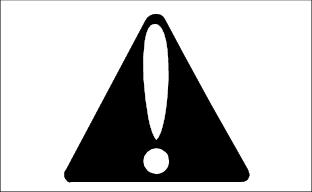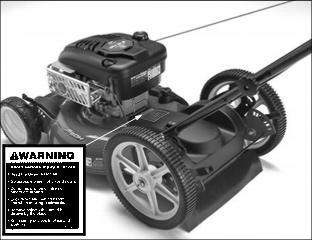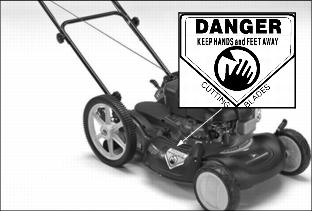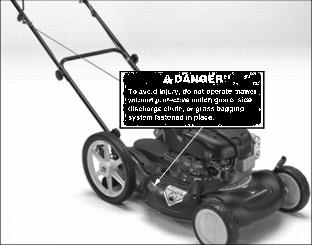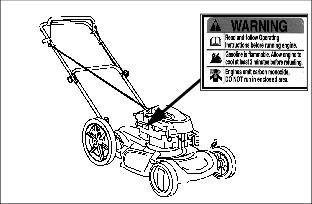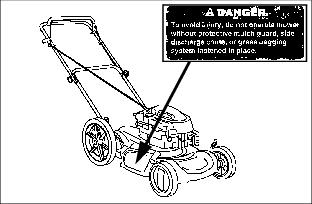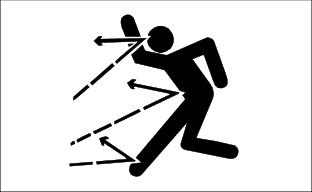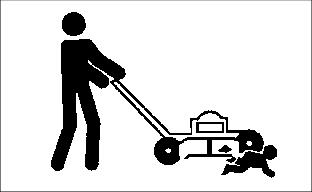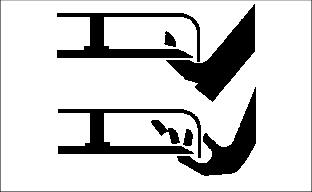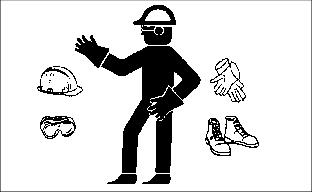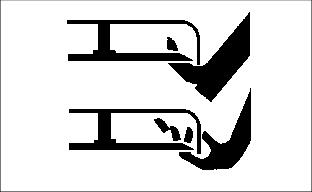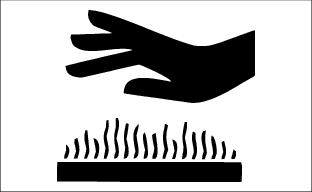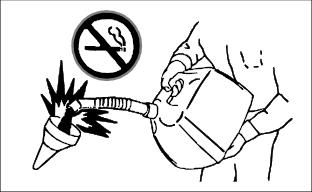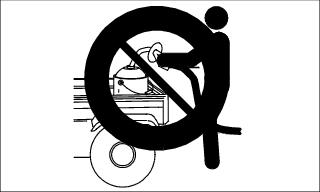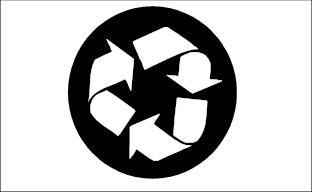21-Inch Walk-Behind Rotary Mowers
Introduction
Product Identification
Safety
Understanding The Machine Safety Labels
WARNING: AVOID SERIOUS INJURY OR DEATH
Emission Control System Certification Label
Rotating Blades are Dangerous - Protect Children and Prevent Accidents
Avoid Injury from Contacting Blade
Handling Waste Product and Chemicals
Operating
Replacement Parts
Service Intervals
Service
Troubleshooting
Storing Machine
Assembly
Specifications
Warranty
John Deere Quality Statement
Service Record

Safety
Understanding The Machine Safety Labels
The machine safety labels shown in this section are placed in important areas on your machine to draw attention to potential safety hazards.
On your machine safety labels, the words DANGER, WARNING, and CAUTION are used with this safety-alert symbol,. DANGER identifies the most serious hazards.
The operator's manual also explains any potential safety hazards whenever necessary in special safety messages that are identified with the word, CAUTION, and the safety-alert symbol,.
WARNING: AVOID SERIOUS INJURY OR DEATH
· Go across slopes, not up and down.
· Do not mow when children or others are around.
· Look down and behind before and while mowing backwards.
· Remove objects that could be thrown by the blade.
· Keep safety devices in place and working.
DANGER:
KEEP HANDS AND FEET AWAY from CUTTING BLADES
DANGER:
To avoid injury, do not operate mower without protective mulch guard, side discharge chute or grass bagging system fastened in place.
DANGER
· Read and follow Operating Instructions before running engine.
· Gasoline is flammable. Allow engine to cool at least 2 minutes before refueling.
· Engines emit carbon monoxide, DO NOT run in enclosed area.
DANGER
To avoid injury, do not operate mower without protective mulch guard, side discharge chute or grass bagging system fastened in place.
Emission Control System Certification Label
NOTE: Tampering with emission controls and components by unauthorized personnel may result in severe fines or penalties. Emission controls and components can only be adjusted by EPA and/or CARB authorized service centers. Contact your John Deere Commercial and Consumer Equipment Retailer concerning emission controls and component questions.
The presence of an emissions label signifies that the engine has been certified with the United States Environmental Protection Agency (EPA) and/or California Air Resources Board (CARB).
The emissions warranty applies only to those engines marketed by John Deere that have been certified by the EPA and/or CARB; and used in the United States and Canada in off-road mobile equipment.
Emission Compliance Period
If your engine has the emission compliance category listed on the emission control system certification or air index label, this indicates the number of operating hours for which the engine has been certified to meet EPA and/or CARB emission requirements. The following table provides the engine compliance period in hours associated with the category found on the certification label.
Operate Safely
· Inspect machine before you operate. Be sure hardware is tight. Repair or replace damaged, badly worn, or missing parts. Be sure proper guards, plates, grass catcher, or other safety protective devices are in good condition and fastened in place. Make any necessary adjustments before you operate.
· Clear work area of objects that might be thrown. Keep people and pets out of the work area. Stop machine if anyone enters the area.
· If you hit an object, stop the machine and inspect it. Make repairs before you operate. Keep machine properly maintained and in good working order.
· Do not leave machine unattended when it is running.
· Only operate during daylight or with good artificial light.
· Be sure of footing. Be especially careful when you pull machine backwards with the engine running.
· Mow across a hill - not up and down. Be careful when you change direction on a slope. Do not mow excessively steep slopes.
· Do not mow wet grass. Reduced traction could cause you to slip.
· Keep a firm hold on the machine handle.
· Do not wear radio or music headphones while operating the machine. Safe operation requires your full attention.
· Do not operate mower if you are under the influence of drugs or alcohol.
Rotating Blades are Dangerous - Protect Children and Prevent Accidents
PROTECT CHILDREN:
· Never assume that children will remain where you last saw them. Children are attracted to mowing activity, stay alert to the presence of children.
· Keep children in the house when you are operating the machine.
· Turn machine off if a child enters the area.
· Use extra care when you come to blind corners, shrubs, trees, or other objects that may block your vision.
· Do not let children or an untrained person operate the machine.
HELP PREVENT SERIOUS OR FATAL ACCIDENTS:
· Be alert at all times, people especially children can move quickly into the area before you know it.
· Stop the blade when crossing gravel drives, walks, or roads.
· Shut off blades when you are not mowing.
· Keep hands, feet, and clothing away from rotating blades.
Wear Appropriate Clothing
· Wear close fitting clothing and safety equipment appropriate for the job.
· Do not operate the equipment when barefoot or wearing open sandals. Always wear substantial footwear.
· Loud noise can cause impairment or loss of hearing. Wear a suitable protective device such as earplugs.
Practice Safe Maintenance
· Understand service procedure before doing work. Keep area clean and dry.
· Never lubricate, service, or adjust machine while it is moving. Keep safety devices in place and in working condition. Keep hardware tight.
· To prevent them from getting caught, keep hands, feet, clothing, jewelry, and long hair away from any moving parts.
· Before servicing machine, disengage all power and stop the engine. Let engine cool.
· Securely support any machine elements that must be raised for service work.
· Keep all parts in good condition and properly installed. Fix damage immediately. Replace worn or broken parts. Remove any buildup of grease, oil, or debris.
· Unauthorized modifications to the machine may impair its function and safety.
Avoid Injury from Contacting Blade
Before you unplug or adjust machine:
· Keep hands, feet and clothing away from blade when engine is running.
Prevent Fires
· Never remove fuel cap, or add fuel with engine running or hot. Allow engine to cool for several minutes.
· Never store equipment with fuel in the tank inside a building where fumes may reach an open flame or spark.
· Allow engine to cool before storing in any enclosure.
· To reduce fire hazard, keep engine free of grass, leaves, or excessive grease.
Handling Fuel Safely
Fuel and fuel vapors are highly flammable:
· Do not refuel machine while you smoke, when machine is near an open flame or sparks, or when engine is running. Stop engine.
· Prevent fires: clean oil, grease and dirt from machine. Clean up spilled fuel immediately.
· Do not store machine with fuel in tank in a building where fumes may reach an open flame or spark.
· Prevent fire and explosion caused by static electric discharge. Use only non-metal, portable fuel containers approved by the Underwriter's Laboratory (U.L.) or the American Society for Testing & Materials (ASTM). If using a funnel, make sure it is plastic and has no screen or filter.
· Static electric discharge can ignite gasoline vapors in an ungrounded fuel container. Remove the fuel container from the bed of a vehicle or the trunk of a car and place on the ground away from the vehicle before filling. Keep nozzle in contact with container opening while filling.
· When practical, remove equipment from trailers or truck beds and refuel them on the ground. If this is not possible, use a portable, plastic fuel container to refuel equipment on a truck bed or trailer.
· Do not use methanol gasoline. Methanol is harmful to the environment and to your health.
Handling Waste Product and Chemicals
Waste products, such as, used oil, fuel, coolant, brake fluid, and batteries, can harm the environment and people:
· Do not use beverage containers for waste fluids - someone may drink from them.
· See your local Recycling Center or John Deere dealer to learn how to recycle or get rid of waste products.
· A Material Safety Data Sheet (MSDS) provides specific details on chemical products: physical and health hazards, safety procedures, and emergency response techniques. The seller of the chemical products used with your machine is responsible for providing the MSDS for that product.

